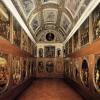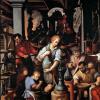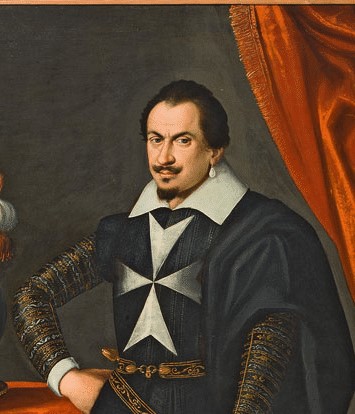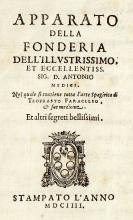Casino di San Marco: 'The House of Nature'
Commentary
'The House of Nature'
The Casino di San Marco was constructed between 1567 and 1574 at the order of Francesco I de' Medici (1541-1587), the Grand Duke of Tuscany (1574-1587). It was designed by the architect Bernardo Buontalenti (1531–1608) on the site of the Orti medicei, the gardens built by Lorenzo il Magnifico (1449-1492) near the convent of San Marco. The building still stands in its original place; currently it is used as a law court and is out of bounds to the public. Buontalenti's architectural features survive; above the monumental door lies the Medici coat of arms and beneath it a representation of an ape crawling out of a sea shell. This is an interpretation of the motif of 'art aping nature'. Here the shell stands for Nature in its feminine form: Buontalenti was probably nodding to the famous Sandro Botticelli painting The Birth of Venus, commissioned by one of the Medici in 1485/86, where Venus is sitting on the same type of scallop shell. The ape is of course the artisan (see the human hands of the ape), perhaps even Francesco himself. The image clearly identifies the purpose of the building; indeed, Francesco wanted the Casino to be both a residence and a laboratory of 'alchemical and physical experiments'. The Bolognese naturalist Ulisse Aldrovandi called it 'the house of nature'.
The Casino was the second of several Medici laboratories (fonderie): the first one, captured by Stradanus, was initially in the Palazzo Vecchio, but it was later migrated to the Casino; further fonderie were established in the Uffizi and Palazzo Pitti.
The Casino brought together many types of works; there was the Medici porcelain workshop, laboratories for distillation, the making of glass, for fireworks and explosives, for goldsmithing, and for creating fake precious stones. A 1621 inventory revealed a huge alchemical library of around 200 books.
The laboratories were all situated on the first floor of the building. The surviving layout from 1621 shows that that the floor was divided in separate rooms for hosting different workshops. In the image, the fonderie itself is at number 6. The smallest room is at no. 3 and represents the porcelain room, and was perhaps initially storing precious pieces of Medici porcelain (soft-paste porcelain). This was apparently first produced at Casino di San Marco: according to the testimony of the Venetian ambassador Andrea Gussoni (1575), Francesco I discovered the secret of making this porcelain after ten years of working on it assiduously. However, the enterprise was apparently abandoned after Francesco's death. Only up to 70 pieces of Medici porcelain survive until today. By 1621, the 'porcelain room' mainly contained books and samples of medicine.
Don Antonio de' Medici
After Francesco died, the ownership of the Casino passed to Don Antonio de' Medici (1576-1621), his (illegitimate) son by Francesco's lover and future wife Bianca Cappello (1548-1587).
Don Antonio continued his father's research into alchemical subjects and also became interested in the Paracelsian framework. Like Francesco, Don Antonio worked in the laboratory himself. A painting called 'The Workshop of the Alchemist' (Il Bottega dell' Alchimista, 1618/19) by Filippo Napoletano seems to portray him in the Casino inspecting an alchemical piece (the image can be viewed here).
Don Antonio collected the recipes practiced at the Casino in four thick volumes, which are still extant. They were prefaced by a printed cover named the Apparato della Fonderia, dated 1604. A smaller anonymous volume, La Fonderia, was published by Don Antonio in 1604; I have found one surviving copy (perhaps the only one ever printed) in the British Library, and this was most likely the one owned by Don Antonio himself. Both titles made reference to Paracelsus and to his art, thus favouring medicine over transmutation as the goal of alchemical efforts.
Today, the Casino is mainly remembered as the place associated with Antonio Neri (1576–1614), an alchemist and glassmaker, who published the first known manual on glassmaking, L'Arte Vetraria (The Art of Glass, 1612). But Neri was primarily a Paracelsian alchemist, who claimed to have the secret of a panacea he called donum Dei. After Neri died, Don Antonio invested a lot of effort to find this precious medicine. He was himself affected by a dreadful disease, syphilis, which he acquired in his years in the army. Unfortunately, he was unable to replicate it and died at the age of only 44. After his death, the Casino fell into gradual disuse, as the Medici princes pursued alchemy and other applied sciences mainly in the Pitti Palace.
Credits: Georgiana D. Hedesan (Nov 2021).
Further Reading:
Hedesan, Georgiana D. "Alchemy and Paracelsianism at the Casino di San Marco in Florence", Nuncius (published online ahead of print 2021), doi: https://doi.org/10.1163/18253911-bja10014
Marco Beretta, “Material and Temporal Powers at the Casino di San Marco (1574–1621),” in Laboratories of Art: Alchemy and Art Technology from Antiquity to the 18th Century, ed. Sven Dupré (Cham: Springer, 2014), 129–156.




